| Listing 1 - 10 of 17 | << page >> |
Sort by
|
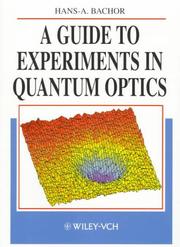
ISBN: 3527292985 Year: 1998 Publisher: Weinheim, : Wiley-VCH,
Abstract | Keywords | Export | Availability | Bookmark
 Loading...
Loading...Choose an application
- Reference Manager
- EndNote
- RefWorks (Direct export to RefWorks)
QUANTUM OPTICS --- EXPERIMENTS --- QUANTUM OPTICS --- EXPERIMENTS
Book
ISBN: 3789053678 Year: 1998 Publisher: Baden-Baden : Nomos Verlagsgesellschaft,
Abstract | Keywords | Export | Availability | Bookmark
 Loading...
Loading...Choose an application
- Reference Manager
- EndNote
- RefWorks (Direct export to RefWorks)
Science --- Science --- Experiments --- History. --- History.
Book
ISBN: 2895442169 1435698967 9781435698963 Year: 1998 Publisher: Sainte-Foy, Quebec : Montreal, Quebec : Editions MultiMondes ; Societe pour la promotion de la science et de la technologie,
Abstract | Keywords | Export | Availability | Bookmark
 Loading...
Loading...Choose an application
- Reference Manager
- EndNote
- RefWorks (Direct export to RefWorks)
Science --- Technology --- Study and teaching (Elementary) --- Experiments.
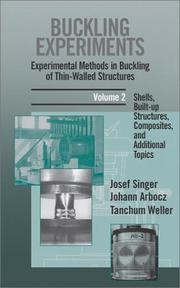
ISBN: 0471956619 0471974501 Year: 1998 Publisher: New York, NY : John Wiley,
Abstract | Keywords | Export | Availability | Bookmark
 Loading...
Loading...Choose an application
- Reference Manager
- EndNote
- RefWorks (Direct export to RefWorks)
Buckling (Mechanics) --- Experiments. --- Constructions, Théorie des --- Constructions, Théorie des --- Experience --- Gauchissement --- Plaque --- Poutre
Book
ISBN: 2804125556 9782804125554 Year: 1998 Volume: *4 Publisher: Bruxelles : De Boeck & Larcier,
Abstract | Keywords | Export | Availability | Bookmark
 Loading...
Loading...Choose an application
- Reference Manager
- EndNote
- RefWorks (Direct export to RefWorks)
Electricité --- Electronique --- Elektriciteit --- Elektronica --- Optica --- Optique --- Problèmes et exercices --- Problèmes et exercices --- Electric power --- Electricity --- Physics --- Electronics --- Optics --- Électricité --- Physique --- Électronique --- Experiments --- Experiments. --- Expériences --- Électricité --- Électronique --- Expériences.
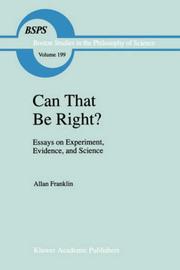
ISBN: 0792354648 9401062420 9401153345 Year: 1998 Volume: 199 Publisher: Dordrecht ; Boston ; London Kluwer academic publishers
Abstract | Keywords | Export | Availability | Bookmark
 Loading...
Loading...Choose an application
- Reference Manager
- EndNote
- RefWorks (Direct export to RefWorks)
In this collection of essays Allan Franklin defends the view that science provides us with knowledge about the world which is based on experimental evidence and on reasoned and critical discussion. In short, he argues that science is a reasonable enterprise. He begins with detailed studies of four episodes from the history of modern physics: (1) the early attempts to detect gravity waves, (2) how the physics community decided that a proposed new elementary particle, 17-keV neutrino, did not exist, (3) a sequence of experiments on K meson decay, and (4) the origins of the Fifth Force hypothesis, a proposed modification of Newton's Law of Universal Gravitation. The case studies are then used to examine issues such as how discord between experimental results is resolved, calibration of an experimental apparatus and its legitimate use in validating an experimental result, and how experimental results provide reasonable grounds for belief in both the truth of physical theories and in the existence of the entities involved in those theories. This book is a challenge to the critics of science, both postmodern and constructivist, to provide convincing alternative explanations of the episodes and issues discussed. It should be of interest to philosophers, historians, and sociologists of science, and to scientists themselves.
-Experiments --- Science --- Experiments --- Philosophy --- Case studies. --- Philosophy. --- Case studies --- Normal science --- Philosophy of science --- Natural science --- Science of science --- Sciences --- Experiments&delete& --- Philosophy&delete& --- Natural sciences --- Philosophy and science. --- Physics. --- History. --- Philosophy of Science. --- History and Philosophical Foundations of Physics. --- History, general. --- Annals --- Auxiliary sciences of history --- Natural philosophy --- Philosophy, Natural --- Physical sciences --- Dynamics --- Science and philosophy
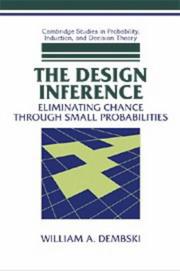
ISBN: 0521623871 0521678676 1139930605 0511891415 0511971559 1139939327 0511570643 1139929593 1139933817 1139937014 9780511570643 9781461958598 1461958598 9780521623872 9780521678674 Year: 1998 Publisher: Cambridge New York Cambridge University Press
Abstract | Keywords | Export | Availability | Bookmark
 Loading...
Loading...Choose an application
- Reference Manager
- EndNote
- RefWorks (Direct export to RefWorks)
The design inference uncovers intelligent causes by isolating their key trademark: specified events of small probability. Just about anything that happens is highly improbable, but when a highly improbable event is also specified (i.e. conforms to an independently given pattern) undirected natural causes lose their explanatory power. Design inferences can be found in a range of scientific pursuits from forensic science to research into the origins of life to the search for extraterrestrial intelligence. This challenging and provocative 1998 book shows how incomplete undirected causes are for science and breathes new life into classical design arguments. It will be read with particular interest by philosophers of science and religion, other philosophers concerned with epistemology and logic, probability and complexity theorists, and statisticians.
Experimental design. --- Probabilities. --- Experimental design --- Probabilities --- Plan d'expérience --- Probabilités --- Probability --- Statistical inference --- Design of experiments --- Statistical design --- Combinations --- Mathematics --- Chance --- Least squares --- Mathematical statistics --- Risk --- Mathematical optimization --- Research --- Science --- Statistical decision --- Statistics --- Analysis of means --- Analysis of variance --- Experiments --- Methodology --- Arts and Humanities --- Philosophy --- Intelligent design (Teleology)
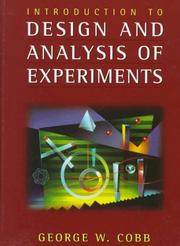
ISBN: 0387946071 Year: 1998 Publisher: New York Springer
Abstract | Keywords | Export | Availability | Bookmark
 Loading...
Loading...Choose an application
- Reference Manager
- EndNote
- RefWorks (Direct export to RefWorks)
Analysis of variance --- Experimental design --- #ABIB:astp --- 519.242 --- 519.2 --- 519.2 Probability. Mathematical statistics --- Probability. Mathematical statistics --- 519.242 Experimental design. Optimal designs. Block designs --- Experimental design. Optimal designs. Block designs --- Design of experiments --- Statistical design --- Mathematical optimization --- Research --- Science --- Statistical decision --- Statistics --- Analysis of means --- ANOVA (Analysis of variance) --- Variance analysis --- Mathematical statistics --- Experiments --- Methodology --- Biological techniques
Article
Abstract | Keywords | Export | Availability | Bookmark
 Loading...
Loading...Choose an application
- Reference Manager
- EndNote
- RefWorks (Direct export to RefWorks)
Intense aggression is the most common behavioural response when pigs from two different groups are put together. The triggering mechanism which elicits the aggressive response appears to be the lack of recognition between the groups. However, recognition among animals may include elements of both previous exposure (familiarity) and genetic relatedness, which are confounded when re-grouping pigs. Two experiments were conducted to determine if recognition among piglets is based on familiarity alone or also involves genetic relatedness. In the first experiment, 80 crossbred piglets from litters crossfostered within 3 days of birth were regrouped in pens of five pigs following weaning at 28 days of age. Each test group was composed of two siblings reared together (ST), an alien (non-related) piglet reared with the two siblings (AT), a sibling reared apart (SA), and an alien piglet reared apart from the other group members (AA). Each pen was videotaped for 6 h following regrouping and the tapes were analyzed to determine the duration of fighting among pairs of pigs and the proportion of time spent lying in contact with other pigs. Dyads which had been reared together spent less time fighting than those reared apart (67 vs. 252 s, respectively; P < 0.0001, general linear model). Related dyads spent a similar amount of time fighting as unrelated pairs (187 s and 131 s, respectively). Although 80% of the piglets demonstrated preferences for lying partners during the observation, no consistent pattern existed across pens for specific pairings. In the second experiment, five litters were each divided into two groups within 72 h after birth and reared on separate sows. At 6 weeks of age pigs were paired either with a full sibling (16 pairs) or a non-sibling (14 pairs), either of which had been reared separately. Reunited full siblings spent a similar amount of time fighting, within the 4 h following regrouping, compared to non-siblings (1425 vs. 1814 s, respectively). Based
Age. --- Aggression. --- Aggressive. --- Animal. --- Animals. --- Association. --- Birth. --- Contact. --- Duration. --- Experiment. --- Experiments. --- Exposure. --- Fighting. --- Genetic. --- Group. --- Lying. --- Model. --- Observation. --- Pattern. --- Patterns. --- Pen. --- Pig. --- Piglets. --- Pigs. --- Preference. --- Preferences. --- Rearing. --- Recognition. --- Regrouping. --- Response. --- Sow. --- Sows. --- Swine. --- Test. --- Time. --- Weaning. --- Young.
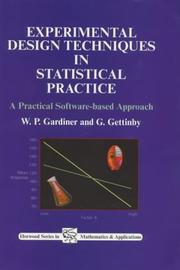
ISBN: 1898563357 0857099787 9780857099785 9781898563358 Year: 1998 Publisher: Chichester, W. Sussex, England
Abstract | Keywords | Export | Availability | Bookmark
 Loading...
Loading...Choose an application
- Reference Manager
- EndNote
- RefWorks (Direct export to RefWorks)
Provides an introduction to the diverse subject area of experimental design, with many practical and applicable exercises to help the reader understand, present and analyse the data. The pragmatic approach offers technical training for use of designs and teaches statistical and non-statistical skills in design and analysis of project studies throughout science and industry.Provides an introduction to the diverse subject area of experimental design and includes practical and applicable exercises to help understand, present and analyse the dataOffers technical training f
Computer vision --- Experimental design --- Mathematical models --- Mathematical statistics --- 519.2 --- 519.2 Probability. Mathematical statistics --- Probability. Mathematical statistics --- Mathematics --- Statistical inference --- Statistics, Mathematical --- Statistics --- Probabilities --- Sampling (Statistics) --- Models, Mathematical --- Simulation methods --- Design of experiments --- Statistical design --- Mathematical optimization --- Research --- Science --- Statistical decision --- Analysis of means --- Analysis of variance --- Machine vision --- Vision, Computer --- Artificial intelligence --- Image processing --- Pattern recognition systems --- Statistical methods --- Experiments --- Methodology --- Experimental design. --- Mathematical models. --- Computer vision. --- Mathematical statistics.
| Listing 1 - 10 of 17 | << page >> |
Sort by
|

 Search
Search Feedback
Feedback About UniCat
About UniCat  Help
Help News
News